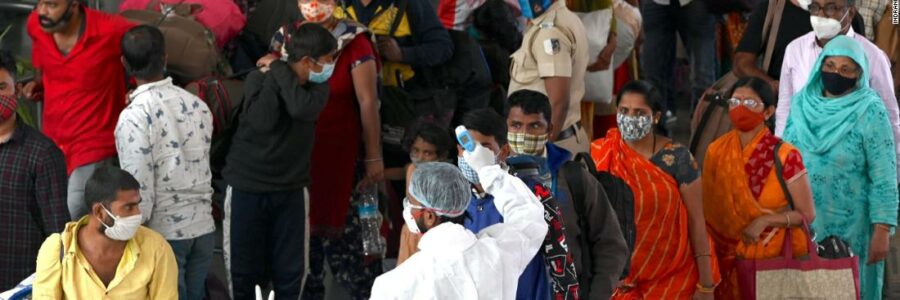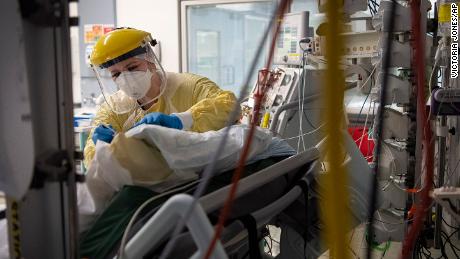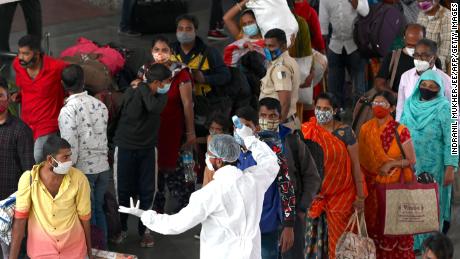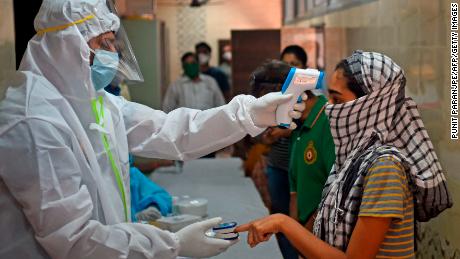
Country has 2nd highest Covid-19 cases. See their vaccine plan
(CNN)Six months ago, India was in crisis. Critically ill Covid-19 patients were being turned away from hospitals. Doctors were collapsing from exhaustion. And the virus was spreading through crowded slums, home to millions of the country’s poorest people.
Today, the country looks very different. Daily new cases have plummeted, dropping from a peak of over 90,000 infections in September down to just over 10,000 a day in February. On February 9, the capital Delhi reported zero virus deaths for the first time in nearly nine months, according to COVID19INDIA, a website that crowdsources Covid-19 data from official sources.
This has all happened without drastic measures such as circuit-breaker lockdowns, which have been used in places like New Zealand and Australia to get outbreaks under control. The Indian government is still implementing certain social distancing restrictions and has scrambled to assist overstretched hospitals — but the economy has reopened, domestic travel has resumed, and people are largely going about their daily lives.
The recovery likely isn’t due to vaccinations, either. India has started its vaccination program, with the goal of inoculating 300 million people by August, but it’s still lagging compared to wealthier nations. So far, the country has administered less than one dose per 100 people, according to Our World In Data, a data aggregation website run by researchers at the University of Oxford.
To put that in perspective, the rate is closer to 27 doses per 100 people in the United Kingdom and 19 doses per 100 people in the United States.
Experts speculate that several factors are likely behind the decline in India’s case numbers, such as the country’s younger population or the possibility of rising immunity in urban areas.
But there’s also the possibility that the case count doesn’t reflect reality. Testing rates have fallen slightly, which could mean more cases are going undetected. In September, the country was conducting more than 1 million tests per day. In February, the number has fallen to between 600,000 to 800,000 a day, according to data from the Indian Council of Medical Research (ICMR), the government’s biomedical research institute.
And the test positivity rate — meaning how many people are testing positive out of all tests conducted — was still hovering at nearly 6% this January and above 5% by late February. A high positivity rate may suggest that the country isn’t testing widely enough; under World Health Organization guidance, countries’ test positivity rates should be at 5% or lower for two weeks before reopening.
Some experts warn that the low case numbers are more cause for caution than celebration — and that people can’t let their guard down, especially as new, potentially more contagious variants spread internationally.
Immunity in big cities
One factor behind the drop in cases could be a rise in people with antibodies, since there are “large numbers of people exposed to infection and thus protected,” said Shahid Jameel, a virologist and director of Ashoka University’s Trivedi School of Biosciences.
Researchers are still studying Covid-19 and how its immunity works. But a US study published in Science earlier this month suggested that after contracting the virus and developing antibodies, patients could be protected against catching it again for at least eight months.
India has reported more than 11 million cases and 156,000 deaths since the pandemic started, according to a tally by Johns Hopkins University.
And national serological surveys that test for antibodies show a sharp rise in various parts of the country. The latest of three surveys conducted by the ICMR, showed a nearly 22% antibody positivity rate in December and January — more than three times higher than last August and September, when an earlier survey found a rate of 6-7%.
The rate is even higher in crowded cities. The August-September survey suggested more than half the residents in Mumbai slums may have been infected before. And more than half of the population in Delhi has been infected with Covid-19, according to a serosurvey conducted by the Delhi government in January.
“This is a huge increase,” community medicine specialist Dr. Hemant Shewade said, adding that big cities may see “considerably reduced” transmission due to the rise in immunity.
However, India is nowhere near herd immunity. There may be enough population immunity to slow infections in large cities, but national herd immunity would require a vast majority of the country’s population to be immune either through previous infection or vaccination. India’s 11 million reported cases so far make up less than 1% of its 1.4 billion people.
“Herd immunity is not something we can consider for the entire country,” Jameel said. And antibody positivity rates vary widely across different regions — apart from the biggest cities, most other places in the country likely have much lower rates, he said.
Herd immunity remains unlikely even when adjusting for underreporting.
“The numbers of exposed people could be in the range of 150 (million) to 900 million — about 350 (million) to 400 million is a more reasonable estimate,” Jameel said, pointing to previous antibody surveys. But that estimate is still only about a quarter of the population. Even the most liberal estimate of 900 million is 65% of the population, which may not be enough to reach herd immunity.
And India might not achieve herd immunity for years, Adar Poonawalla, CEO of Serum Institute of India, the country’s largest vaccine manufacturer, has said.
“Until you get that real magical 90% herd immunity or vaccine immunity, which will come after three or four years, you really should exercise precautions,” Poonawalla said in a January interview with CNN.
Demography, geography and living conditions
India’s relatively young population may be another factor that has helped push down the country’s case numbers, since infections in younger patients tend to see milder symptoms and lower mortality rates.
Half the population are 25 or younger, and 65% are under 35, according to figures from India’s 2011 census.
“A younger population means largely asymptomatic infection or mild disease, which is not tested and does not show up in reported cases,” Jameel said.
Jameel added that there could also be a biological component, or what is known as the “hygiene hypothesis,” which posits that extremely clean environments could create a weaker immune system. The hypothesis theorizes that those living in places with a “higher incidence of infectious disease,” such as India, may develop better innate immunity, which could help prevent Covid-19 infections from becoming too severe.
Geography plays a part as well, Raman Gangakhedkar, former head scientist of epidemiology and communicable diseases at the ICMR, said.
“It’s also important to remember that around 70% of Indians live in rural areas, where you’ll find that ventilation is better and people’s bubbles are smaller,” he said. “A person living in a rural area doesn’t travel by bus or train, their network is smaller (…) There’s less risk compared to the risk for someone in an urban area.”
Finally, there’s the government’s efforts. India placed the country under a strict lockdown for several months last spring, which lifted before the September peak. Though travel and business have largely resumed, there are still restrictions in place, such as mask mandates, social distancing rules and caps on the number of people allowed in public gatherings.
“We had a very long lockdown that was successfully followed, and we have been able to shift the curve by at least five to six months,” Gangakhedkar said. “Things are gradually being lifted so we don’t add a lot of infections.”
Authorities have also worked to provide more treatment resources, which could have helped limit severe infection and mortality, said Jameel. The federal government airlifted doctors from the Central Armed Police Forces to Delhi in November, doubled mobile testing capacity, and made 300 additional ICU beds available in the city.
Don’t get too comfortable
The drop in cases looks promising, but experts are warning the public not to get complacent or rely too much on official case numbers.
If places have fewer reported cases, it could simply be that those areas aren’t offering enough tests, or that local authorities have made errors in reporting and registering cases. The official death toll, too, has come under scrutiny for underreporting.
“In India, we also have states where the data that comes in is not as reliable,” Shewade said. “We shouldn’t praise states that are reporting less. States like Bihar aren’t doing well. They’re just not reporting cases or deaths.”
Bihar health authorities did not respond to a request for comment.
And just because the national total in daily new cases is declining, it doesn’t mean the situation is improving everywhere. The state of Maharashtra is currently seeing a resurgence in cases and issued fresh restrictions on February 19, including new rules for home quarantine, strict penalties for not wearing masks in public and the lockdown of any building with more than five positive cases.
After issuing the new restrictions, Maharashtra Chief Minister Uddhav Thackeray warned that the state could reimpose lockdown if daily new cases continued to rise in the next two weeks.
Experts are also concerned that the low number of reported cases could cause a false sense of security before the crisis has fully ended. It’s too early to relax restrictions and protective measures, they say, especially with the threat of new coronavirus variants that have been spotted in many countries.
“There is complacency all around us,” Jameel said. “Vaccine derived protection is not available to most since only select groups are getting those. Further, the second dose is rolling out only now. But if a fast moving variant starts community transmission, the dynamics could change very quickly.”
India has already reported more than 180 cases of a variant first detected in the United Kingdom, as well as several cases of variants first detected in South Africa and Brazil. And recovering from the peak of infection doesn’t mean India is safe from a potential second wave, Jameel said.
“Although cases and positivity rate are declining, coronavirus has still not gone away and is still affecting our population, the country’s health ministry said in a press release.
“Hopefully these (variant) strains will not cause catastrophic situations, but the vigil to contain this disease must continue.”
Source: Read Full Article




